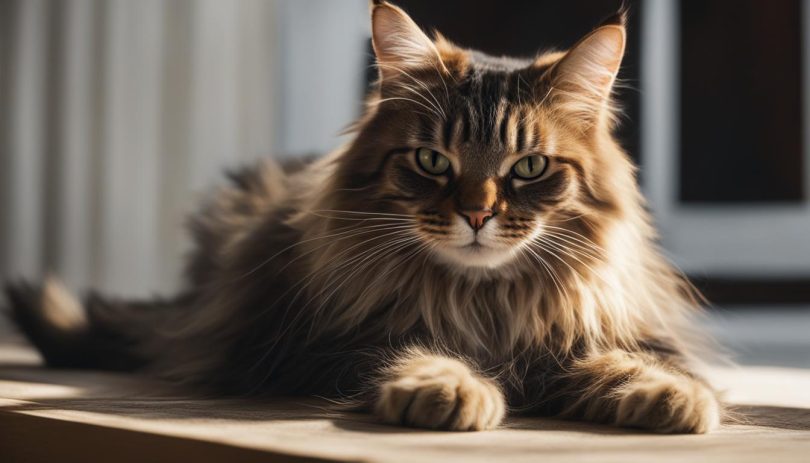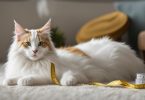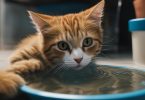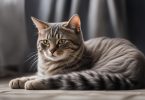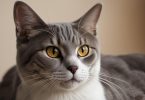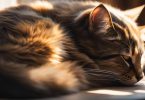Cats are fascinating creatures known for their independence, agility, and their meticulous grooming habits. As they meticulously groom themselves, you may have noticed something rather peculiar your furry companion nibbling on their own hair. It’s a behavior that can leave pet owners puzzled and wondering why cats engage in such an unusual activity. In this article, we delve into the intriguing world of feline behavior to uncover the reasons behind this seemingly odd habit: why do cats eat their hair?
Join us as we explore the scientific explanations and delve into the fascinating insights into our feline friends’ grooming rituals. Get ready to unlock the secrets behind this puzzling behavior that has captivated cat lovers around the world.
Key Takeaways:
- Cats eat their hair as a natural instinct to maintain their sleek coats and eliminate loose hairs.
- Excessive hair ingestion or compulsive grooming can indicate underlying health issues that need attention.
- Hair eating can lead to issues such as hairballs, intestinal blockages, and dental problems.
- Common causes of hair eating in cats include stress, anxiety, boredom, and medical conditions.
- Preventing and treating hair eating involves methods such as regular brushing, flea treatment, and environmental enrichment.
What is Hair Eating and Why Do Cats Do It?
Hair eating, also known as trichophagia, is a condition where cats ingest their own hair or fur. This can happen accidentally, as cats groom themselves with their tongues, which have tiny barbs that catch loose hair. Some of this hair may end up in their stomachs, forming hairballs that they eventually vomit or pass through their stools. However, some cats may eat their hair deliberately and excessively, which can cause serious health issues.
Cat grooming plays a significant role in hair eating behavior. Cats are meticulous groomers, and their tongues are designed to remove dirt, debris, and loose fur from their coats. While grooming, cats use their sharp tongues to lick their fur, and the barbs on their tongues collect loose hairs. In most cases, these hairs are easily swallowed and pass through the digestive system without causing any problems. This natural process helps cats to maintain their sleek coats and keep them clean.
However, when cats excessively groom themselves or engage in compulsive licking, they may end up ingesting large amounts of hair. This can lead to the formation of hairballs in their stomachs, which are difficult to pass through the digestive tract. In some cases, the hair may accumulate and cause intestinal blockages, leading to severe discomfort and potential health complications. Additionally, excessive hair ingestion can interfere with the absorption of essential nutrients, resulting in malnutrition over time.
It’s important to note that hair eating in cats can also be a sign of underlying health issues or emotional problems. Cats may engage in excessive grooming and hair eating as a response to stress, anxiety, or boredom. It can be a self-soothing behavior that helps them cope with their emotions. If you notice your cat excessively grooming or eating their hair, it is essential to consult with a veterinarian to rule out any underlying medical conditions and address any behavioral issues.
Table: Common Causes and Risks of Hair Eating in Cats
| Cause | Risks/Consequences |
|---|---|
| Compulsive grooming | – Hairballs – Intestinal blockages – Malnutrition |
| Stress and anxiety | – Behavioral issues – Digestive problems – Hair loss |
| Boredom | – Behavioral issues – Malnutrition – Skin irritation |
| Pica | – Digestive problems – Nutritional deficiencies |
| Fleas or skin injuries | – Itchiness – Skin infections – Hair loss |
Common Causes of Hair Eating in Cats
When it comes to cats eating their hair, there are several common causes that pet owners should be aware of. One of the primary reasons is overgrooming, which can occur when a cat is experiencing stress and anxiety. Cats may engage in excessive grooming as a way to self-soothe, but this can lead to the ingestion of hair.
Another potential cause of hair eating is a condition called pica, which is characterized by the consumption of non-food items. In some cases, cats with pica may eat their hair as a result of boredom or a nutritional deficiency. It’s important to address the underlying cause of pica to prevent hair eating.
Additionally, external factors such as fleas or skin injuries can contribute to hair eating in cats. Fleas can cause itching and discomfort, leading to excessive grooming and hair ingestion. Similarly, skin injuries may prompt a cat to groom the affected area excessively, resulting in the consumption of hair.
In summary, common causes of hair eating in cats include overgrooming due to stress and anxiety, pica resulting from boredom or nutritional deficiencies, and external factors like fleas or skin injuries. By identifying these causes, pet owners can take steps to address the underlying issues and prevent hair eating in their feline companions.
How to Tell if Your Cat is Eating Their Hair
If you suspect that your cat may be eating their hair, there are several signs and symptoms to look out for. These can help you determine if your cat is engaging in hair consumption and if further attention or intervention is required. Keep an eye out for the following:
- Hair loss: Excessive hair eating may result in noticeable hair loss, especially in specific areas where your cat tends to groom excessively.
- Hairballs: Increased hair consumption can lead to the formation of hairballs in your cat’s stomach, which may cause vomiting or difficulty in passing stools.
- Weight loss: If your cat is consistently eating their hair, it can lead to a decrease in appetite and subsequent weight loss.
- Excessive licking: Cats that eat their hair often exhibit excessive licking behavior, particularly in the areas where they groom themselves the most.
- Skin irritation: Hair consumption can irritate your cat’s skin, resulting in redness, inflammation, or the development of sores.
If you notice any of these signs in your cat, it’s essential to consult with a veterinarian. They can evaluate your cat’s health, provide a proper diagnosis, and recommend the appropriate steps to address the hair eating behavior.
Table: Signs of Hair Eating in Cats
| Signs | Description |
|---|---|
| Hair loss | Excessive grooming may result in noticeable hair loss in specific areas. |
| Hairballs | Increased hair consumption can lead to the formation of hairballs, causing vomiting or difficulty in passing stools. |
| Weight loss | Consistent hair eating may lead to a decrease in appetite and subsequent weight loss. |
| Excessive licking | Cats that eat their hair often exhibit excessive licking behavior, especially in areas of excessive grooming. |
| Skin irritation | Hair consumption can cause skin irritation, resulting in redness, inflammation, or sores. |
Remember, while observing these signs can help you identify if your cat is eating their hair, a professional veterinary evaluation is crucial for a proper diagnosis and treatment plan.
How to Prevent and Treat Hair Eating in Cats
Preventing and treating hair eating in cats is essential to ensure their overall health and well-being. By addressing the underlying causes and providing appropriate care, you can help your furry friend avoid the potential complications associated with excessive hair ingestion. Here are some effective methods to consider:
Regular Brushing:
Brushing your cat regularly helps to remove loose and excess hair from their coat, minimizing the amount of hair they ingest during grooming. Use a soft-bristled brush or a grooming glove to gently comb through their fur, paying extra attention to areas prone to shedding. This not only reduces the risk of hairballs but also strengthens the bond between you and your cat.
Flea Treatment:
Fleas can cause excessive itching and discomfort, leading to overgrooming and increased hair consumption in cats. Consult with your veterinarian to determine the most suitable flea preventative treatment for your cat. By effectively controlling fleas, you can alleviate your cat’s urge to groom excessively and reduce the ingestion of hair.
Wound Care:
If your cat has any open wounds or skin injuries, it’s crucial to provide proper wound care to prevent infection and further complications. Keep the affected area clean and consult with your veterinarian for appropriate wound management. By addressing any skin issues promptly, you can minimize your cat’s need to excessively groom and ingest hair.
Stress Relief and Environmental Enrichment:
Stress and boredom can contribute to compulsive behaviors like excessive grooming and hair eating in cats. Provide your cat with plenty of mental and physical stimulation through interactive toys, scratching posts, and climbing structures. Additionally, create a calm and secure environment for your cat by establishing routines, providing hiding spots, and offering a comfortable resting area. If you suspect your cat is stressed, consider consulting with a veterinarian or a feline behaviorist for guidance on stress relief techniques.
By implementing these preventive measures and addressing any underlying issues, you can help your cat break the cycle of hair eating and promote their overall well-being.
| Preventive Measures | Treatment Methods |
|---|---|
| Regular brushing | Brushing your cat regularly helps to remove loose and excess hair from their coat, minimizing the amount of hair they ingest during grooming. |
| Flea treatment | Consult with your veterinarian to determine the most suitable flea preventative treatment for your cat. By effectively controlling fleas, you can alleviate your cat’s urge to groom excessively and reduce the ingestion of hair. |
| Wound care | If your cat has any open wounds or skin injuries, it’s crucial to provide proper wound care to prevent infection and further complications. |
| Stress relief and environmental enrichment | Provide your cat with plenty of mental and physical stimulation through interactive toys, scratching posts, and climbing structures. Additionally, create a calm and secure environment for your cat. |
Conclusion
Understanding cat behavior, particularly the mystery behind why cats eat their hair, provides valuable insights into their grooming habits and overall well-being. While it may seem like an unusual habit, hair consumption during grooming is a natural instinct for cats. It allows them to maintain their sleek coats and eliminate loose hairs.
However, it is important to note that excessive hair ingestion or compulsive grooming can be indicative of underlying health issues in cats. If you notice your cat excessively consuming hair, it is crucial to seek veterinary attention. This behavior can lead to problems such as hairballs, intestinal blockages, malnutrition, dental issues, and infections.
Prevention and early intervention are key when it comes to hairball prevention in cats. Regular brushing, flea treatment, wound care, stress relief, and environmental enrichment can all contribute to minimizing hair eating behaviors. By addressing the root causes and providing appropriate care, you can help your feline friend maintain a healthy coat and overall well-being.
FAQ
What is hair eating in cats?
Hair eating, also known as trichophagia, is a condition where cats ingest their own hair or fur. This can happen accidentally during grooming or as a deliberate and excessive behavior.
Why do cats eat their hair?
Cats eat their hair as part of their grooming routine. Their tongues have tiny barbs that catch loose hair while they groom, and some of this hair may end up in their stomachs. However, excessive hair ingestion can be a sign of stress, anxiety, boredom, or a medical condition.
What are the health issues associated with hair eating in cats?
Hair eating can lead to intestinal blockages, malnutrition, dental problems, and infections in cats. It is important to address this behavior and seek appropriate treatment to prevent these health issues.
What are the signs that my cat is eating their hair?
Signs of hair eating in cats include hair loss, hairballs, weight loss, excessive licking, and skin irritation. If you notice any of these signs, it is recommended to consult with a veterinarian.
How can I prevent and treat hair eating in cats?
Prevention and treatment methods for hair eating in cats include regular brushing to minimize shedding, flea treatment to prevent itching, wound care for any skin injuries, stress relief techniques, and providing environmental enrichment to combat boredom.
What are the key takeaways about hair eating in cats?
Hair eating is a natural instinct for cats during grooming, but excessive hair ingestion can indicate underlying health issues. Understanding and addressing this behavior is crucial for the well-being of your furry friend.
